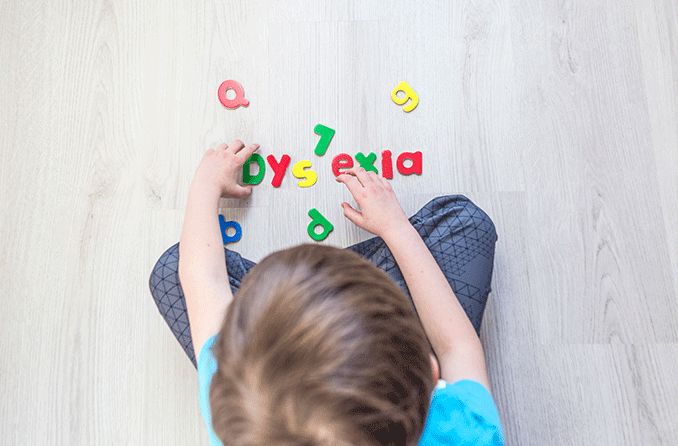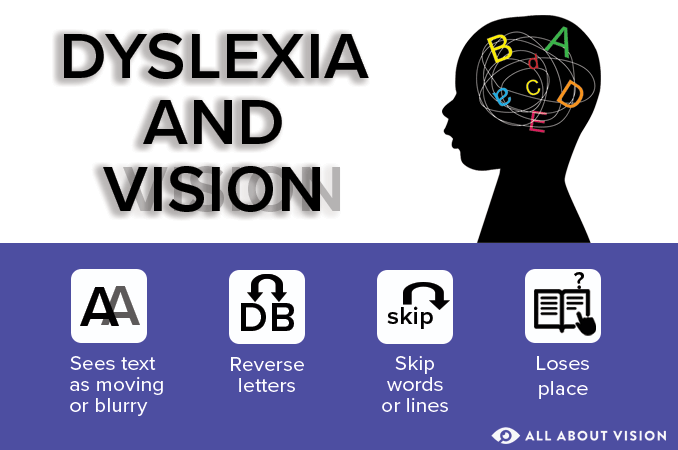Dyslexia and vision: Are they connected?

What is dyslexia?
When you hear the word “dyslexia,” you may think it’s a vision problem that makes it hard to read. Difficulty reading is one of the symptoms of dyslexia, but it’s not the whole story. Also, dyslexia is not a vision problem. In fact, dyslexia.org defines it as a learning disability involving language.
Dyslexia is a collection of symptoms that affects how a person understands and interacts with language. It’s estimated that 80% to 90% of children who have a learning disability deal with dyslexia.
People with dyslexia may struggle to learn in many ways, such as:
This video shows where a dyslexic child was looking when she was reading. [Video credit: Permission to reuse granted by Dyslexia Gold: https://dyslexiagold.co.uk/.]
Reading confidently without making mistakes
Comprehending what they read
Sounding out what they read
Spelling
Writing
Recognizing familiar words in text
Rhyming
Studying a foreign language
It’s important to note that dyslexia has nothing to do with intelligence.
No one knows exactly what causes dyslexia, but there are a couple of widely agreed upon associations. Heredity plays an important role in a person’s risk of having dyslexia. Up to 49% of parents whose kids have dyslexia also have it. If a child has dyslexia, about 40% of their siblings do as well.
Brain structure and how the brain works suggest how dyslexia may develop in a person. Images of the brain have shown differences in people with dyslexia.
These differences exist in the areas of the brain that recognize how sounds are represented in text. These areas of the brain also perceive what words in text look like. They are parts of the brain key to helping a person read and comprehend what they read.
Are dyslexia and vision related?
Up to 80% of what a child learns is visual, so being able to see clearly is critical for children to learn. If a child is having trouble reading, adults may assume it’s because the child needs glasses. Reading problems can be a sign that a child may not be able to see clearly. But this is not always the case.
Children with dyslexia are not more likely to have vision problems. But they can have both dyslexia and vision issues. Some children have more severe dyslexia that also affects their visual processing. Even in serious cases, vision is not the cause. The cause of dyslexia is always how the brain processes what the eyes see.
Most parents don’t know how to tell the difference between a vision problem and a learning disability. If your child has trouble reading, it’s time to take them for an eye exam.
Vision problems that affect learning
While dyslexia is not a vision problem, there are vision issues that affect learning:
Refractive errors, including nearsightedness, farsightedness and astigmatism. These problems with visual acuity can be corrected with glasses, contact lenses or vision surgery.
Low vision is an impairment that can’t be fixed with glasses, contacts, medication or surgery.
Functional vision problems. Functional vision refers to how the eyes function to perform tasks, like reading.
Visual perception problems. Visual perception enables the brain to understand and process what is seen.
Children often don’t know they have poor vision. So parents need to watch for signs and symptoms that a child may have a vision problem that’s interfering with their education:

Lines of text are skipped or repeated while reading aloud
Reading comprehension is lacking
Homework seems especially challenging and takes longer than it should to complete
Letters like b and d are reversed when reading
Attention span is short when reading or doing schoolwork
If you notice your child exhibiting any of these challenges, take them to the eye doctor for an eye exam. If your child has a vision problem, the good news is, 80% of vision impairment can be managed, often with a pair of glasses.
What is Irlen Syndrome?
Irlen Syndrome is a condition that resembles dyslexia. Irlen Syndrome is a problem with how the brain processes visual information but is not a vision problem.
People with Irlen Syndrome are often misdiagnosed as having dyslexia. Some symptoms of Irlen Syndrome include:
Problems paying attention and concentrating
Headaches, including migraines
Trouble with depth perception
Fatigue
Educational and medical tests can’t diagnose Irlen Syndrome. But, there is a way to identify it. Also, Irlen Syndrome is easily treatable.
Support for people with dyslexia
Dyslexia affects people of all ages, and it’s not something a person outgrows. Fortunately, there are tools, apps, accommodations and support groups for people with dyslexia.
For kids with dyslexia, reading, spelling and writing can be hard. Students may feel discouraged if they can’t keep up with their classmates.
There are several things teachers can do in the classroom to help children with dyslexia:
Assign worksheets and present materials in large-print text.
Give students extra time for reading and writing assignments.
Supply bookmarks or strips of paper to help students track what they’re reading.
Give students notes or an outline of the lesson to help them take notes.
Check in with the student to make sure they are following and understanding the lesson.
Provide extra time to complete tests.
Other resources to help people with dyslexia include:
Text-to-speak settings on a computer
Apps to help with topics such as reading, spelling, writing and math
Support groups and online forums for individuals with and families of those with dyslexia
Provider directories listing professionals who work with people with learning disabilities
Dyslexia is a learning disability. And there are many tools available to help kids and adults with dyslexia succeed both in school and in life.
Talk to your eye doctor
Whether you or your child struggle with dyslexia or you worry you may have problems with your vision, keep up with routine eye exams. Keeping your vision in check is always important. Plus, your eye doctor may be able to refer you to a care provider if you are concerned about dyslexia.
READ NEXT: Could it be ADHD or a vision problem?
Complete guide to dyslexia. Child Mind Institute. Accessed June 2022.
Dyslexia. Understood. 2018.
Frequently asked questions. International Dyslexia Association. Accessed June 2022.
What is dyslexia? Understood. Accessed June 2022.
Irlen Syndrome infographic. Irlen Syndrome Foundation. Accessed June 2022.
Irlen self tests. Irlen Syndrome Foundation. Accessed June 2022.
Dyslexia. College of Optometrists in Vision Development. Accessed June 2022.
FAQs about dyslexia and vision. Understood. Accessed June 2022.
Signs & symptoms of learning-related vision problems. College of Optometrists in Vision Development. Accessed June 2022.
World Sight Day: Learn more about “avoidable blindness” and schedule a comprehensive eye examination. Vision Aware. October 2018.
Classroom accommodations for dyslexia. Understood. Accessed June 2022.
Tools. Headstrong Nation. Accessed June 2022.
Apps for dyslexia and learning disabilities. Dyslexia Help at the University of Michigan. Accessed June 2022.
Support for dyslexics & web resources. Dyslexia Help at the University of Michigan. Accessed June 2022.
Provider directories. International Dyslexia Association. Accessed June 2022.
Page published on Wednesday, June 29, 2022
Medically reviewed on Tuesday, June 21, 2022






